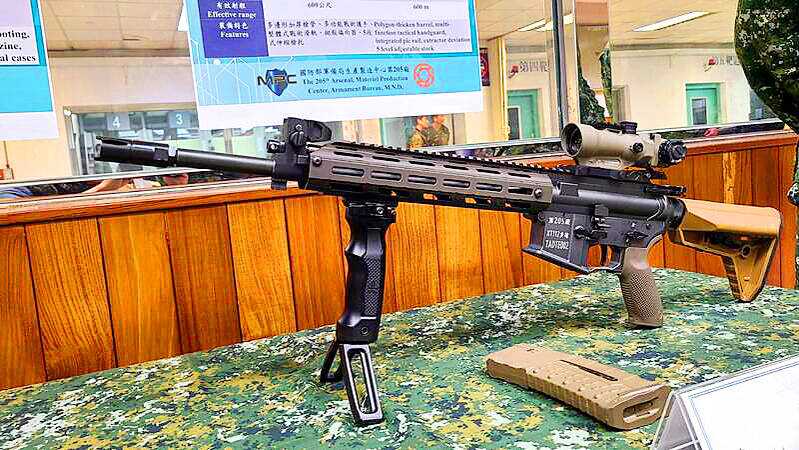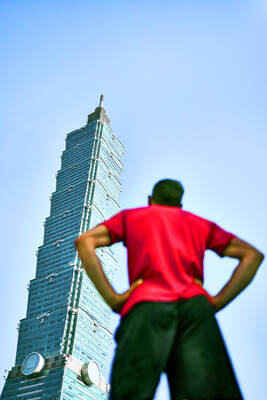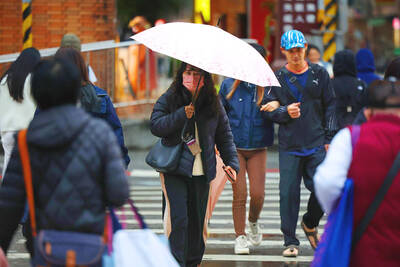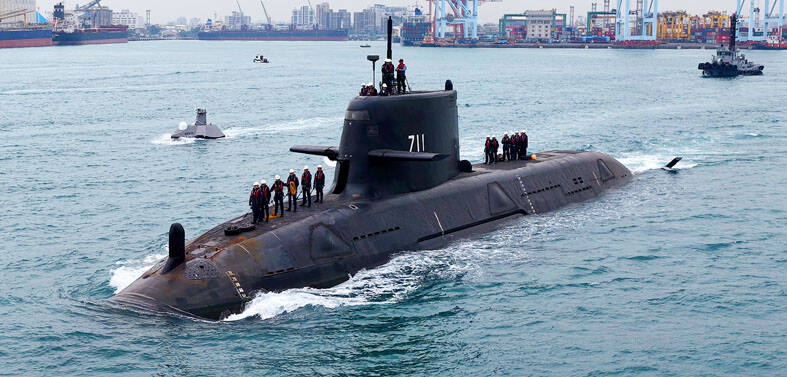The Taiwanese army’s new standard combat rifle, the T112, has entered mass production with 25,000 units in the pipeline, a military source close to the matter said.
It debuted last year at the Taipei Aerospace & Defense Industry Exhibition, at which time were designated as XT112.
The T112 combat rifle, which is scheduled to replace the T91 assault rifle the Republic of China Army currently uses, is a 5.56x54mm weapon weighing 3.5kg and measuring 940mm, with a fully extended telescoping stock, the Armaments Bureau’s 205th Arsenal said.

Photo: Taipei Times
Equipped with a single shot, two-round burst and fully automatic firing modes, the rifle is effective up to 600m, an arsenal spokesman said, adding that superior ergonomics has improved its functionality and stability during firing.
Features include a five-position adjustable telescoping stock contoured for better cheek weld, an improved flash hider and a universal bayonet mount for a variety of bayonets and combat daggers, he said.
It is also a fully ambidextrous system with a charging handle that can be operated on either side, dual magazine release and fire group selector, and a deflector near the ejection port to protect a left-handed shooter’s face from spent carriage casings, he added.
The rifle utilizes a 30-round polymer magazine that is stronger than previous aluminum-based designs, reducing the chance of misfeeds, while a transparent window allows shooters to see the number of remaining bullets, the spokesperson said.
The carrying handle above the receiver has been obviated as modern riflemen march in shorter distances and have little need for this feature, with an optics mount taking its place, he added.
Modern infantry combat places a premium on the rifle’s ability to adapt optics and an improved shoulder strap design is used for ease of carriage, he said.
The assault rifle also has a dedicated laser illuminator, optical sights and flashlights currently under development, with the red dot close combat optics and advanced combat optics being particularly important, the spokesperson said, adding that these features would significantly augment soldiers’ capabilities in night combat and fighting at range.
The advanced combat optic would be a four-power scope with a ring-shaped reticle, mil dots for targets out to 300m and bullet drop compensation for targets up to 600m, enhancing combat marksmanship, he said.
The T112 rifle makes use of an M-LOK handguard, a modular design that allows tactical accessories to be attached and adjusted to fit the user’s preferences and operational needs, the spokesperson said.
The Armaments Bureau also revealed a sample of the T112 heavy bolt action sniper rifle chambered in a 12.7x99mm Browning, the first domestically designed weapon of its type.
The 205th Arsenal is confident in the sniper rifle’s performance, as the system has undergone a side-by-side evaluation with the Accuracy International AX50, the spokesman said.
The heavy sniper rifle weighs 12kg and is fed with a 10-round magazine, with an effective range of 2,000m, he said.
The design also emphasized ergonomics, equipped with a folding stock, an adjustable cheek weld and recoil pad, a M-LOK handguard, an aluminum receiver and a suppressor-ready flash hider, the spokesperson said.
The sniper rifle has completed its operational evaluation and more than 100 units has been ordered to equip Taiwanese special operations forces, he added.

US climber Alex Honnold is to attempt to scale Taipei 101 without a rope and harness in a live Netflix special on Jan. 24, the streaming platform announced on Wednesday. Accounting for the time difference, the two-hour broadcast of Honnold’s climb, called Skyscraper Live, is to air on Jan. 23 in the US, Netflix said in a statement. Honnold, 40, was the first person ever to free solo climb the 900m El Capitan rock formation in Yosemite National Park — a feat that was recorded and later made into the 2018 documentary film Free Solo. Netflix previewed Skyscraper Live in October, after videos

NUMBERS IMBALANCE: More than 4 million Taiwanese have visited China this year, while only about half a million Chinese have visited here Beijing has yet to respond to Taiwan’s requests for negotiation over matters related to the recovery of cross-strait tourism, the Tourism Administration said yesterday. Taiwan’s tourism authority issued the statement after Chinese-language daily the China Times reported yesterday that the government’s policy of banning group tours to China does not stop Taiwanese from visiting the country. As of October, more than 4.2 million had traveled to China this year, exceeding last year. Beijing estimated the number of Taiwanese tourists in China could reach 4.5 million this year. By contrast, only 500,000 Chinese tourists are expected in Taiwan, the report said. The report

Temperatures are forecast to drop steadily as a continental cold air mass moves across Taiwan, with some areas also likely to see heavy rainfall, the Central Weather Administration (CWA) said. From today through early tomorrow, a cold air mass would keep temperatures low across central and northern Taiwan, and the eastern half of Taiwan proper, with isolated brief showers forecast along Keelung’s north coast, Taipei and New Taipei City’s mountainous areas and eastern Taiwan, it said. Lows of 11°C to 15°C are forecast in central and northern Taiwan, Yilan County, and the outlying Kinmen and Lienchiang (Matsu) counties, and 14°C to 17°C

STEERING FAILURE: The first boat of its class is experiencing teething issues as it readies for acceptance by the navy, according to a recent story about rudder failure The Hai Kun (海鯤), the nation’s first locally built submarine, allegedly suffered a total failure of stern hydraulic systems during the second round of sea acceptance trials on June 26, and sailors were forced to manually operate the X-rudder to turn the submarine and return to port, news Web site Mirror Daily reported yesterday. The report said that tugboats following the Hai Kun assisted the submarine in avoiding collisions with other ships due to the X-rudder malfunctioning. At the time of the report, the submarine had completed its trials and was scheduled to begin diving and surfacing tests in shallow areas. The X-rudder,